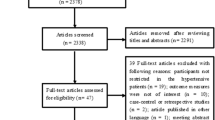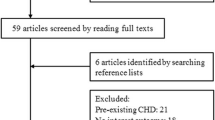Abstract
Studies on the association of uric acid with mortality and cardiovascular outcomes in patients with hypertension have produced contradictory results. The objective of this meta-analysis was to evaluate the prognostic utility of uric acid in hypertensive patients. We comprehensively searched PubMed and Embase databases (until July 31, 2020) to identify eligible studies that reported the association of uric acid with mortality and cardiovascular outcomes in hypertensive patients. Outcome measures included cardiovascular or all-cause mortality, coronary artery disease (CAD), stroke, and major adverse cardiovascular events (MACEs). Eleven eligible studies of 49,800 hypertensive patients were identified. For patients with the highest than those with reference lower group of uric acid level, the pooled hazard ratio (HR) was 1.51 (95% confidence interval [CI] 1.12–2.02) for all-cause mortality, 1.68 (95% CI 1.28–2.20) for cardiovascular mortality, 1.31 (95% CI 1.10–1.55) for CAD, and 1.48 (95% CI 1.28–1.70) for MACEs. However, there was no significant association between elevated uric acid level and incident stroke in hypertensive patients. This meta-analysis indicates that elevated uric acid level is significantly associated with an increased risk of cardiovascular or all-cause mortality, CAD and MACEs in hypertensive patients. Hypertensive patients with highest uric acid level exhibited a tendency for reduced risk of stroke, but the difference is not significant.





Similar content being viewed by others
References
Wang J, Qin T, Chen J, Li Y, Wang L, Huang H, Li J (2014) Hyperuricemia and risk of incident hypertension: a systematic review and meta-analysis of observational studies. PLoS ONE 9(12):e114259
Buzas R, Tautu OF, Dorobantu M, Ivan V, Lighezan D (2018) Serum uric acid and arterial hypertension-Data from Sephar III survey. PLoS ONE 13(7):e0199865
Zhao G, Huang L, Song M, Song Y (2013) Baseline serum uric acid level as a predictor of cardiovascular disease related mortality and all-cause mortality: a meta-analysis of prospective studies. Atherosclerosis 231(1):61–68
Yue M, Zhang H, Li R (2016) Meta-analysis on the risk of all-cause mortality and cardiovascular death in the early stage of hypertension. Pak J Pharm Sci 29(4 Suppl):1343–1351
Khoury SR, Ratchford EV (2018) Hypertension. Vasc Med 23(3):293–297
Alderman MH, Cohen H, Madhavan S, Kivlighn S (1999) Serum uric acid and cardiovascular events in successfully treated hypertensive patients. Hypertension 34(1):144–150
Verdecchia P, Schillaci G, Reboldi G, Santeusanio F, Porcellati C, Brunetti P (2000) Relation between serum uric acid and risk of cardiovascular disease in essential hypertension. The PIUMA study. Hypertension 36(6):1072–1078
Turak O, Afsar B, Ozcan F, Canpolat U, Grbovic E, Mendi MA, Oksuz F, Siriopol D, Covic A, Caliskan M, McFann K, Johnson RJ, Kanbay M (2014) Relationship between elevated morning blood pressure surge, uric acid, and cardiovascular outcomes in hypertensive patients. J Clin Hypertens (Greenwich) 16(7):530–535
Wang J, Wang Y, Zhao D, Guo X, Zhong JQ (2015) Association between serum uric acid and mortality in a Chinese population of hypertensive patients. Ren Fail 37(1):73–76
Franse LV, Pahor M, Di Bari M, Shorr RI, Wan JY, Somes GW, Applegate WB (2000) Serum uric acid, diuretic treatment and risk of cardiovascular events in the Systolic Hypertension in the Elderly Program (SHEP). J Hypertens 18(8):1149–1154
Kawai T, Ohishi M, Takeya Y, Onishi M, Ito N, Yamamoto K, Kamide K, Rakugi H (2012) Serum uric acid is an independent risk factor for cardiovascular disease and mortality in hypertensive patients. Hypertens Res 35(11):1087–1092
Dawson J, Jeemon P, Hetherington L, Judd C, Hastie C, Schulz C, Sloan W, Muir S, Jardine A, McInnes G, Morrison D, Dominiczak AF, Padmanabhan S, Walters M (2013) Serum uric acid level, longitudinal blood pressure, renal function, and long-term mortality in treated hypertensive patients. Hypertension 62(1):105–111
Shi X, Yang J, Wang L, Zhao M, Zhang C, He M, Qin X, Tang G, Li J, Zhang Y, Huo Y, Cai Y, Zhao G, Dong Q, Xu X, Wang B, Fu J, Wang K (2017) Prospective study of serum uric acid levels and stroke in a Chinese hypertensive cohort. Clin Exp Hypertens 39(6):527–531
Liberati A, Altman DG, Tetzlaff J, Mulrow C, Gotzsche PC, Ioannidis JP, Clarke M, Devereaux PJ, Kleijnen J, Moher D (2009) The PRISMA statement for reporting systematic reviews and meta-analyses of studies that evaluate health care interventions: explanation and elaboration. J Clin Epidemiol 62(10):e1-34
Wells G, Shea B, O'Connell D, Peterson J, Welch V, Losos M, Tugwell P (2020) The Newcastle–Ottawa Scale (NOS) for assessing the quality if nonrandomized studies in meta-analyses. http://www.ohri.ca/programs/clinical_epidemiology/oxford.asp. Assessed 28 Aug 2020
Begg CB, Mazumdar M (1994) Operating characteristics of a rank correlation test for publication bias. Biometrics 50(4):1088–1101
Egger M, Davey Smith G, Schneider M, Minder C (1997) Bias in meta-analysis detected by a simple, graphical test. BMJ 315(7109):629–634
Andrikou I, Tsioufis C, Dimitriadis K, Konstantinidis D, Kasiakogias A, Kouremeti M, Andrikou E, Karapati I, Kalos T, Fragoulis C, Liatakis I, Koutra E, Kyriazopoulos K, Thomopoulos C, Tousoulis D (2018) Uric acid as an independent predictor of coronary artery disease in essential hypertension: data from an 8-year-follow-up study. Clin Exp Pharmacol Physiol 45(8):866–869
Gu J, Fan YQ, Zhang HL, Zhang JF, Wang CQ (2018) Serum uric acid is associated with incidence of heart failure with preserved ejection fraction and cardiovascular events in patients with arterial hypertension. J Clin Hypertens (Greenwich) 20(3):560–567
Sun SS, Cai Y, Xu WH, Huang X, Yang WY, Luo JK, Ma YF, Cai J (2020) Effect of asymptomatic hyperuricemia on all-cause death and cardiovascular events in elderly hypertensive patients. Chin J Geriatr Heart Brain Vessel Dis 22(4):368–371
Huang G, Qin J, Deng X, Luo G, Yu D, Zhang M, Zhou S, Wang L (2019) Prognostic value of serum uric acid in patients with acute heart failure: a meta-analysis. Medicine (Baltimore) 98(8):e14525
Wang R, Song Y, Yan Y, Ding Z (2016) Elevated serum uric acid and risk of cardiovascular or all-cause mortality in people with suspected or definite coronary artery disease: a meta-analysis. Atherosclerosis 254:193–199
Xia X, Luo Q, Li B, Lin Z, Yu X, Huang F (2016) Serum uric acid and mortality in chronic kidney disease: a systematic review and meta-analysis. Metabolism 65(9):1326–1341
Perticone M, Tripepi G, Maio R, Cimellaro A, Addesi D, Baggetta R, Sciacqua A, Sesti G, Perticone F (2017) Risk reclassification ability of uric acid for cardiovascular outcomes in essential hypertension. Int J Cardiol 243:473–478
Wang JG, Staessen JA, Fagard RH, Birkenhager WH, Gong L, Liu L (2001) Prognostic significance of serum creatinine and uric acid in older Chinese patients with isolated systolic hypertension. Hypertension 37(4):1069–1074
Tsioufis C, Kyvelou S, Dimitriadis K, Syrseloudis D, Sideris S, Skiadas I, Katsi V, Stefanadi E, Lalos S, Mihas C, Poulakis M, Stefanadis C (2011) The diverse associations of uric acid with low-grade inflammation, adiponectin and arterial stiffness in never-treated hypertensives. J Hum Hypertens 25(9):554–559
Esen AM, Akcakoyun M, Esen O, Acar G, Emiroglu Y, Pala S, Kargin R, Karapinar H, Ozcan O, Barutcu I (2011) Uric acid as a marker of oxidative stress in dilatation of the ascending aorta. Am J Hypertens 24(2):149–154
Zapolski T, Wacinski P, Kondracki B, Rychta E, Buraczynska MJ, Wysokinski A (2011) Uric acid as a link between renal dysfunction and both pro-inflammatory and prothrombotic state in patients with metabolic syndrome and coronary artery disease. Kardiol Pol 69(4):319–326
Zoccali C, Maio R, Mallamaci F, Sesti G, Perticone F (2006) Uric acid and endothelial dysfunction in essential hypertension. J Am Soc Nephrol 17(5):1466–1471
Tsioufis C, Chatzis D, Vezali E, Dimitriadis K, Antoniadis D, Zervoudaki A, Lalos S, Kallikazaros I, Stefanadis C, Toutouzas P (2005) The controversial role of serum uric acid in essential hypertension: relationships with indices of target organ damage. J Hum Hypertens 19(3):211–217
Fan Y, Wei F, Lang Y, Wang S (2015) Losartan treatment for hypertensive patients with hyperuricaemia in Chinese population: a meta-analysis. J Hypertens 33(4):681–688 (discussion 689)
Tykarski A, Widecka K, Filipiak KJ (2015) Zasady postępowania w nadciśnieniu tętniczym—2015 rok. Wytyczne Polskiego Towarzystwa Nadciśnienia Tętniczego. Próba komentarza na temat ich zasadności. Nadciśnienie Tętnicze w Praktyce 1(1):71–79
Funding
None.
Author information
Authors and Affiliations
Corresponding author
Ethics declarations
Conflict of interest
None of the authors have relevant conflicts of interest.
Additional information
Publisher's Note
Springer Nature remains neutral with regard to jurisdictional claims in published maps and institutional affiliations.
Rights and permissions
About this article
Cite this article
Yang, Y., Zhang, X., Jin, Z. et al. Association of serum uric acid with mortality and cardiovascular outcomes in patients with hypertension: a meta-analysis. J Thromb Thrombolysis 52, 1084–1093 (2021). https://doi.org/10.1007/s11239-021-02453-z
Accepted:
Published:
Issue Date:
DOI: https://doi.org/10.1007/s11239-021-02453-z




